Day-542
Quiz-summary
0 of 5 questions completed
Questions:
- 1
- 2
- 3
- 4
- 5
Information
DAILY MCQ
You have already completed the quiz before. Hence you can not start it again.
Quiz is loading...
You must sign in or sign up to start the quiz.
You have to finish following quiz, to start this quiz:
Results
0 of 5 questions answered correctly
Your time:
Time has elapsed
You have reached 0 of 0 points, (0)
Categories
- Not categorized 0%
- 1
- 2
- 3
- 4
- 5
- Answered
- Review
-
Question 1 of 5
1. Question
1. Consider the following statements in the context of lead pollution:
1. Lead is commonly found in paints and cigarette smoke.
2. Exposure to lead can cause neurodegenerative diseases.
3. Unlike other toxins, lead can be naturally excreted from the human body.
How many of the above statements are correct?Correct
Answer: B
Explanation:
Statement 1 is correct: Lead is commonly found in paints, ceramic cookware, cigarette smoke, PVC plastics, lead acid batteries, etc.
Cigarette smoke is known to contain several toxic and heavy metals such as cadmium, lead, copper, nickel, chromium, and zinc.
The sources of lead are as follows:
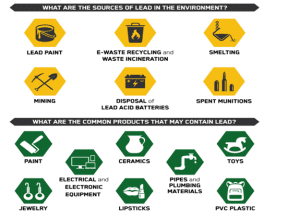
Statement 2 is correct: Lead is a metal which harms both the environment and human health. Exposure to lead can cause numerous and severe neurological problems including nerve damage, cognitive problems, loss of IQ and possibly even conditions such as Alzheimer’s disease.
During pregnancy, if the woman consumes lead in some form, there is no placental barrier either, so the lead is transferred to the foetus. In a newborn, lead poisoning can result in premature birth, low birth weight and slow growth. In children and adults, it can cause anaemia as well as neurological, skeletal and neuromuscular illnesses.
There is no known safe level of lead in the human body. However, WHO regulations specify a tolerable limit of 5 μg/dL for lead exposure, beyond which lead poisoning occurs.
Treatment for lead poisoning involves chelation, in which the patient is given medication that binds with lead molecules and facilitates their excretion through urine.
Statement 3 is incorrect: Lead, unlike many other toxins, does not get diluted when exposure decreases. Nor does the body excrete it naturally. Instead, it accumulates in the bones and leaches into blood.

Additional information-
● Management of lead-acid batteries came under the Batteries (Management and Handling) Rules, 2001.
● In 2022, the Union Ministry of Environment, Forest and Climate Change notified the Battery Waste Management Rules, 2022. The new rules aim at reducing share of battery recycling in the informal sector and stress on extended producer responsibility.Incorrect
Answer: B
Explanation:
Statement 1 is correct: Lead is commonly found in paints, ceramic cookware, cigarette smoke, PVC plastics, lead acid batteries, etc.
Cigarette smoke is known to contain several toxic and heavy metals such as cadmium, lead, copper, nickel, chromium, and zinc.
The sources of lead are as follows:

Statement 2 is correct: Lead is a metal which harms both the environment and human health. Exposure to lead can cause numerous and severe neurological problems including nerve damage, cognitive problems, loss of IQ and possibly even conditions such as Alzheimer’s disease.
During pregnancy, if the woman consumes lead in some form, there is no placental barrier either, so the lead is transferred to the foetus. In a newborn, lead poisoning can result in premature birth, low birth weight and slow growth. In children and adults, it can cause anaemia as well as neurological, skeletal and neuromuscular illnesses.
There is no known safe level of lead in the human body. However, WHO regulations specify a tolerable limit of 5 μg/dL for lead exposure, beyond which lead poisoning occurs.
Treatment for lead poisoning involves chelation, in which the patient is given medication that binds with lead molecules and facilitates their excretion through urine.
Statement 3 is incorrect: Lead, unlike many other toxins, does not get diluted when exposure decreases. Nor does the body excrete it naturally. Instead, it accumulates in the bones and leaches into blood.


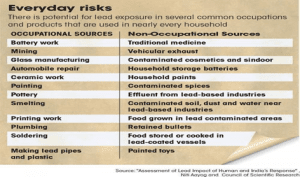
Additional information-
● Management of lead-acid batteries came under the Batteries (Management and Handling) Rules, 2001.
● In 2022, the Union Ministry of Environment, Forest and Climate Change notified the Battery Waste Management Rules, 2022. The new rules aim at reducing share of battery recycling in the informal sector and stress on extended producer responsibility. -
Question 2 of 5
2. Question
2. Consider the following provisions of the Wildlife (Protection) Act, 1972:
1. The onus of immunization of livestock within at least ten km of a Wildlife Sanctuary is on the government authorities.
2. The diversion of area of two (or more) connected tiger reserves for unsustainable projects requires the approval of the National Tiger Conservation Authority as well as the National Board for Wildlife.
3. Plants and their derivatives lawfully collected from any National Park are considered the property of respective State governments.
How many of the above statements are correct?Correct
Answer: A
Explanation:
Statement 1 is incorrect: As per the provisions of Section 33(A) of the Wildlife (Protection) Act 1972, the onus of immunization of livestock within at least 5 km of Wildlife Sanctuary is on the State government.
It states that it is the responsibility of the Chief Wildlife Warden to take measures necessary for immunisation against communicable diseases of the live-stock kept in or within five kilometres of a sanctuary. Also, it prohibits the entry of any livestock in a sanctuary without getting it immunised.
Statement 2 is correct: The Sec. 38(O) of the Wildlife (Protection) Act 1972 states that the diversion of area of two (or more) connected tiger reserves for unsustainable projects requires the approval of both the National Tiger Conservation Authority (NTCA) and the National Board for Wildlife (NBW).
Sec. 38(W) of the Act also specifies that no alteration in the boundaries of a tiger reserve shall be made except on a recommendation of the Tiger Conservation Authority and the approval of the National Board for Wildlife.
Statement 3 is incorrect: As per the provisions of Section 17(H) of the Wildlife Protection Act, every specified plant or part or derivative thereof, which has been lawfully collected or acquired from a sanctuary or National Park declared by the Central Government, shall be the property of the Central Government.Incorrect
Answer: A
Explanation:
Statement 1 is incorrect: As per the provisions of Section 33(A) of the Wildlife (Protection) Act 1972, the onus of immunization of livestock within at least 5 km of Wildlife Sanctuary is on the State government.
It states that it is the responsibility of the Chief Wildlife Warden to take measures necessary for immunisation against communicable diseases of the live-stock kept in or within five kilometres of a sanctuary. Also, it prohibits the entry of any livestock in a sanctuary without getting it immunised.
Statement 2 is correct: The Sec. 38(O) of the Wildlife (Protection) Act 1972 states that the diversion of area of two (or more) connected tiger reserves for unsustainable projects requires the approval of both the National Tiger Conservation Authority (NTCA) and the National Board for Wildlife (NBW).
Sec. 38(W) of the Act also specifies that no alteration in the boundaries of a tiger reserve shall be made except on a recommendation of the Tiger Conservation Authority and the approval of the National Board for Wildlife.
Statement 3 is incorrect: As per the provisions of Section 17(H) of the Wildlife Protection Act, every specified plant or part or derivative thereof, which has been lawfully collected or acquired from a sanctuary or National Park declared by the Central Government, shall be the property of the Central Government. -
Question 3 of 5
3. Question
3. Consider the following statements:
Statement I: Black rhinos have hooked upper lips, whereas white rhinos have squared lips.
Statement II: The black rhino is a browser and feeds on leaves, shoots, and branches.
Which one of the following is correct in respect of the above statements?Correct
Answer: A
Explanation:
Black Rhino and White Rhino are found in the African continent.
Statement 1 is correct: Among black and white rhinos, black rhinos are the smaller of the two African rhino species. Black and white rhinos can be distinguished by the shape of their lips. Black rhinos have hooked upper lips, whereas white rhinos are characterized by a square lip.
Statement 2 is correct and explains statement 1: Black rhinos are browsers, rather than grazers, meaning they are herbivores who do not feed on low-growing vegetation, and their pointed lip helps them feed on leaves from bushes and trees.
A white rhinoceros has a very broad, flat, wide lip, which gives this creature the right idea as a grazer and requires a mouth designed for it. The broad muscular lips are ideal for tearing and tearing the grass.
HABITATS: Semi-Desert Savannah, Woodlands, Forests, Wetlands
DISTRIBUTION: Black rhinos or Dicerosbicornis are spread across 12 African countries including Kenya, Namibia, Botswana, South Africa, Tanzania, Zimbabwe, and Zambia.


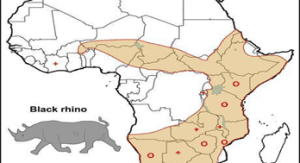
Additional Information:
DIFFERENCES BETWEEN WHITE RHINO AND BLACK RHINO:


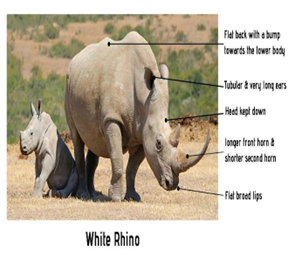


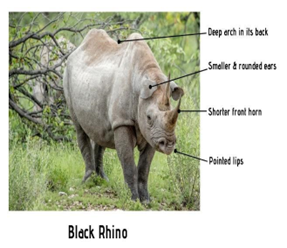
PARAMETER – BLACK RHINO – WHITE RHINO
1. Size of body – Smaller and more compact physical structure.It has shorter face compared to white rhino. However, it prefers keeping its head lifted because it spends most of its time eating trees. – Taller, bigger, and more complex physical structure.It has a long face, small eyes and a neck weakened because it does not need to be raised so large to feed.
2. Structure of lips – Black rhinos feed on leaves and branches. Accordingly, their lips shape has evolved into a pointed lip (with the shape of a hook) to be able to grab hold of the trees. – Squared lips. White rhinos are grazers, so flat and broad lips serve excellently to the purpose.
3. Ears – Since black rhinos are less dependent on just one sense, as they have better eye-sight than white rhinos. This results in black rhinos having smaller and rounded ears. – White rhinos’ ears are tubular and very long, acting as little satellites to keep them aware of the surroundings.
4. Volume of body – A black rhino that weighs between 800 – 1,400 kg. – A white rhino female weighs about 1,700 kg and a male weighs about 2,300 kg.
5. Length of horn – The black rhinos have shorter front horns than white rhinos, but the second horn is slightly shorter. – A white rhino will usually have a longer front horn and a much shorter second horn.
6. Habitat and Behaviour – The black rhinos are most commonly spotted in dense brush.Black rhinos have a reputation for being more aggressive and territorial than white rhinos. – White rhinos prefer to live in grasslands and fields. White rhinos are calmer and more placid.
7. IUCN status – Critically Endangered (CR) – Near Threatened (NT)Incorrect
Answer: A
Explanation:
Black Rhino and White Rhino are found in the African continent.
Statement 1 is correct: Among black and white rhinos, black rhinos are the smaller of the two African rhino species. Black and white rhinos can be distinguished by the shape of their lips. Black rhinos have hooked upper lips, whereas white rhinos are characterized by a square lip.
Statement 2 is correct and explains statement 1: Black rhinos are browsers, rather than grazers, meaning they are herbivores who do not feed on low-growing vegetation, and their pointed lip helps them feed on leaves from bushes and trees.
A white rhinoceros has a very broad, flat, wide lip, which gives this creature the right idea as a grazer and requires a mouth designed for it. The broad muscular lips are ideal for tearing and tearing the grass.
HABITATS: Semi-Desert Savannah, Woodlands, Forests, Wetlands
DISTRIBUTION: Black rhinos or Dicerosbicornis are spread across 12 African countries including Kenya, Namibia, Botswana, South Africa, Tanzania, Zimbabwe, and Zambia.



Additional Information:
DIFFERENCES BETWEEN WHITE RHINO AND BLACK RHINO:






PARAMETER – BLACK RHINO – WHITE RHINO
1. Size of body – Smaller and more compact physical structure.It has shorter face compared to white rhino. However, it prefers keeping its head lifted because it spends most of its time eating trees. – Taller, bigger, and more complex physical structure.It has a long face, small eyes and a neck weakened because it does not need to be raised so large to feed.
2. Structure of lips – Black rhinos feed on leaves and branches. Accordingly, their lips shape has evolved into a pointed lip (with the shape of a hook) to be able to grab hold of the trees. – Squared lips. White rhinos are grazers, so flat and broad lips serve excellently to the purpose.
3. Ears – Since black rhinos are less dependent on just one sense, as they have better eye-sight than white rhinos. This results in black rhinos having smaller and rounded ears. – White rhinos’ ears are tubular and very long, acting as little satellites to keep them aware of the surroundings.
4. Volume of body – A black rhino that weighs between 800 – 1,400 kg. – A white rhino female weighs about 1,700 kg and a male weighs about 2,300 kg.
5. Length of horn – The black rhinos have shorter front horns than white rhinos, but the second horn is slightly shorter. – A white rhino will usually have a longer front horn and a much shorter second horn.
6. Habitat and Behaviour – The black rhinos are most commonly spotted in dense brush.Black rhinos have a reputation for being more aggressive and territorial than white rhinos. – White rhinos prefer to live in grasslands and fields. White rhinos are calmer and more placid.
7. IUCN status – Critically Endangered (CR) – Near Threatened (NT) -
Question 4 of 5
4. Question
4. Consider the following statements about rhododendrons:
1. Rhododendrons are restricted to the Eastern Himalayas only.
2. Usually, they are not found in the regions where mosses and lichens are found.
3. The phenology of rhododendrons can be an important indicator of climate change.
How many of the above statements are correct?Correct
Answer: A
Explanation:
Rhododendron is mostly concentrated in the temperate regions of northern hemisphere especially in Sino-Himalayas (Eastern Himalayas and Western China). A good number are also found in Myanmar, China, Japan, Thailand, Malaysia, Indonesia, Philippines and New Guinea. Most rhododendrons are found in high rainfall, humid temperate regions of highly organic well-drained acidic soils and reach their magnificent development in the high hills and mountains that have dry, cool summer and rainy seasons.
Statement 1 is incorrect: Rhododendrons are found in abundance in the eastern Himalayas in India but they are also distributed in the Western Himalayas and Western Ghats.


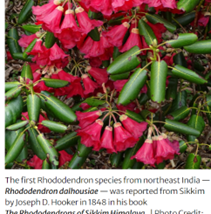
● Of the four parallel ranges in Himalayas, rhododendrons are practically absent in the Shiwaliks, a few are found in the lesser Himalayas and majority of them are in the greater Himalayas.
● Only one species occurs in Trans-Himalayan region located in extreme north-west of India (including the cold deserts of Jammu and Kashmir and Himachal Pradesh). The greater Himalayas are thus an ideal locality for rhododendrons in India.
● Besides this, a good number of species are found in north-eastern India particularly in Naga and Khasi hills.
● One subspecies, nilagiricum of Rhododendron arboreum occurs in Western Ghats.
● State-wise, Arunachal Pradesh harbours the maximum number of species (67 species) followed by Sikkim (36 species).
Statement 2 is incorrect: Mosses and lichens are commonly found in association with rhododendron species. The epilithic/epiphytic rhododendrons grow on the moss-wrapped rocks and tree trunks associated with Agapetes, Vaccinium and orchids.
Eight species are found growing epilithically/epiphytically, which are confined to eastern Himalayas and north-east India. Such species are entirely absent in western Himalayas.
Statement 3 is correct: Rhododendron, meaning rose tree in Greek, is considered an indicator species for climate change. Generally, the flowering season for rhododendrons starts in March and continues till May. However, recently, flowering was found to begin as early as January for some species. This is an indication that those areas are getting warmer, and the phenology (the timing of biological events such as flowering and fruiting) of rhododendrons can be an important indicator of climate change.
Of the 45 taxa of rhododendrons documented by the Botanical Survey of India, five are facing a high threat due to anthropological pressures and climate change.Incorrect
Answer: A
Explanation:
Rhododendron is mostly concentrated in the temperate regions of northern hemisphere especially in Sino-Himalayas (Eastern Himalayas and Western China). A good number are also found in Myanmar, China, Japan, Thailand, Malaysia, Indonesia, Philippines and New Guinea. Most rhododendrons are found in high rainfall, humid temperate regions of highly organic well-drained acidic soils and reach their magnificent development in the high hills and mountains that have dry, cool summer and rainy seasons.
Statement 1 is incorrect: Rhododendrons are found in abundance in the eastern Himalayas in India but they are also distributed in the Western Himalayas and Western Ghats.



● Of the four parallel ranges in Himalayas, rhododendrons are practically absent in the Shiwaliks, a few are found in the lesser Himalayas and majority of them are in the greater Himalayas.
● Only one species occurs in Trans-Himalayan region located in extreme north-west of India (including the cold deserts of Jammu and Kashmir and Himachal Pradesh). The greater Himalayas are thus an ideal locality for rhododendrons in India.
● Besides this, a good number of species are found in north-eastern India particularly in Naga and Khasi hills.
● One subspecies, nilagiricum of Rhododendron arboreum occurs in Western Ghats.
● State-wise, Arunachal Pradesh harbours the maximum number of species (67 species) followed by Sikkim (36 species).
Statement 2 is incorrect: Mosses and lichens are commonly found in association with rhododendron species. The epilithic/epiphytic rhododendrons grow on the moss-wrapped rocks and tree trunks associated with Agapetes, Vaccinium and orchids.
Eight species are found growing epilithically/epiphytically, which are confined to eastern Himalayas and north-east India. Such species are entirely absent in western Himalayas.
Statement 3 is correct: Rhododendron, meaning rose tree in Greek, is considered an indicator species for climate change. Generally, the flowering season for rhododendrons starts in March and continues till May. However, recently, flowering was found to begin as early as January for some species. This is an indication that those areas are getting warmer, and the phenology (the timing of biological events such as flowering and fruiting) of rhododendrons can be an important indicator of climate change.
Of the 45 taxa of rhododendrons documented by the Botanical Survey of India, five are facing a high threat due to anthropological pressures and climate change. -
Question 5 of 5
5. Question
5. Consider the following statements:
Statement I: Antibiosis is a specific type of amensalism.
Statement II: In antibiosis, one organism produces toxic chemicals that may have antagonistic effect on another organism but has no effect on the former.
Which one of the following is correct in respect of the above statements?Correct
Answer: A
Explanation:
Statement 1 is correct: Antibiosis is a specific type of amensalism. Amensalism defines the association between organisms of two different species in which one is inhibited or destroyed and the other is unaffected. There are two basic modes:
● Competition, in which a larger or stronger organism excludes a smaller or weaker one from living space or deprives it of food, and
● Antibiosis, in which one organism is unaffected but the other is damaged or killed by a chemical secretion.
Statement 2 is correct and explains statement 1: Antibiosis can be defined as the antagonism resulting from the toxicity of secondary metabolites produced by one microorganism for other microorganisms.
The classic demonstration of antibiosis is the destructive effect that the bread mold Penicillium has upon certain bacteria; the secretion, known as penicillin, has become a potent medicine in combating bacterial infections.
Some higher plants secrete substances that inhibit the growth of—or kill outright—nearby competing plants. An example is the black walnut (Juglans nigra), which secretes juglone, a substance that destroys many herbaceous plants within its root zone.
Antibiosis may involve an important role in plant disease suppression by certain bacteria and fungi. Microorganism performs an active role in the suppression of pathogens by secreting one or more antibiotics.Incorrect
Answer: A
Explanation:
Statement 1 is correct: Antibiosis is a specific type of amensalism. Amensalism defines the association between organisms of two different species in which one is inhibited or destroyed and the other is unaffected. There are two basic modes:
● Competition, in which a larger or stronger organism excludes a smaller or weaker one from living space or deprives it of food, and
● Antibiosis, in which one organism is unaffected but the other is damaged or killed by a chemical secretion.
Statement 2 is correct and explains statement 1: Antibiosis can be defined as the antagonism resulting from the toxicity of secondary metabolites produced by one microorganism for other microorganisms.
The classic demonstration of antibiosis is the destructive effect that the bread mold Penicillium has upon certain bacteria; the secretion, known as penicillin, has become a potent medicine in combating bacterial infections.
Some higher plants secrete substances that inhibit the growth of—or kill outright—nearby competing plants. An example is the black walnut (Juglans nigra), which secretes juglone, a substance that destroys many herbaceous plants within its root zone.
Antibiosis may involve an important role in plant disease suppression by certain bacteria and fungi. Microorganism performs an active role in the suppression of pathogens by secreting one or more antibiotics.

